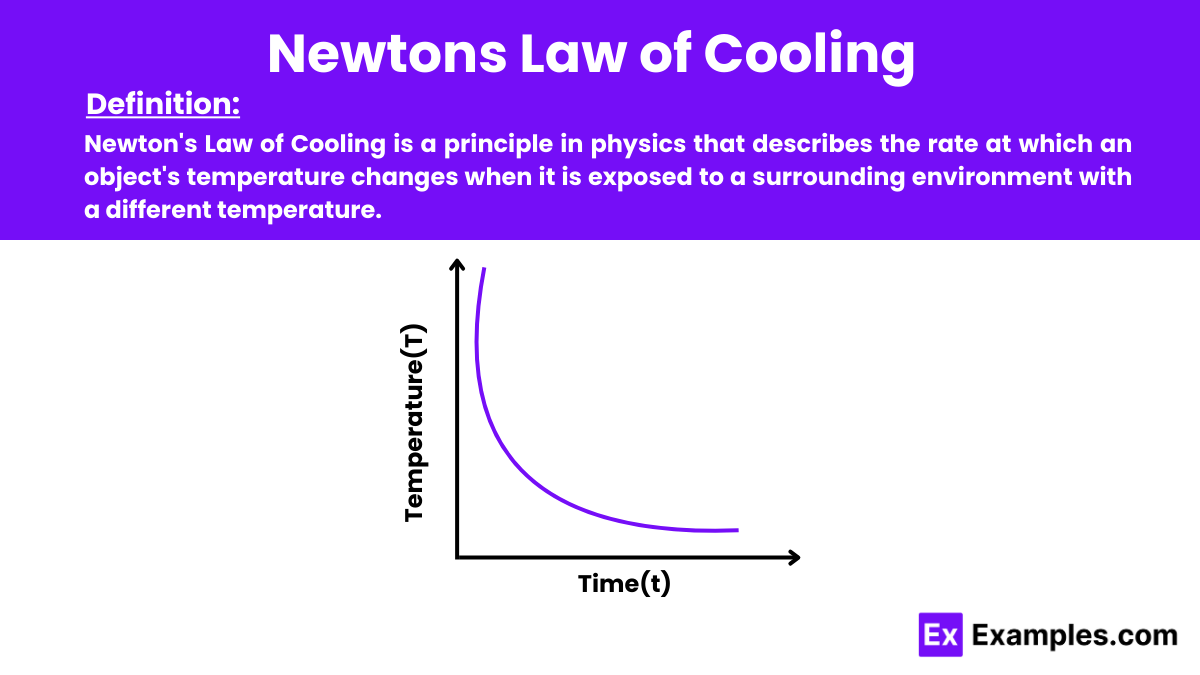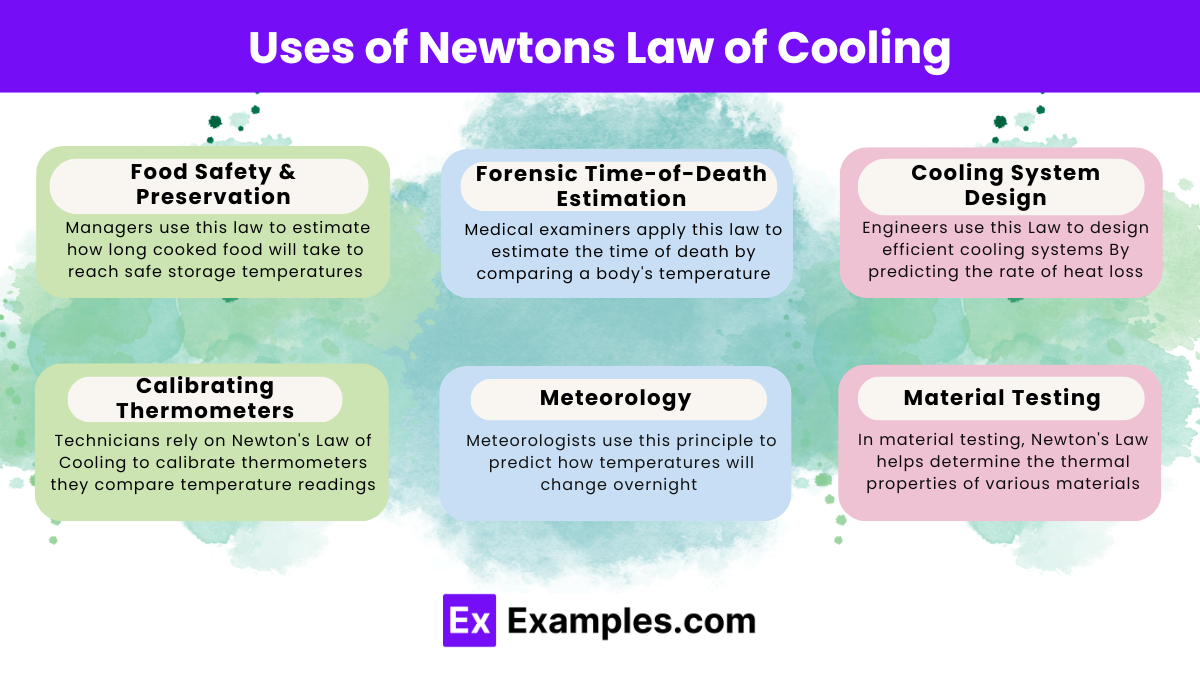What is Newton's Law of Cooling primarily used to describe?
Heat conduction
Heat convection
Rate of temperature change of an object
Radiation of heat


Newton’s Law of Cooling is a principle in physics that describes the rate at which an object’s temperature changes when it is exposed to a surrounding environment with a different temperature. According to this law of physics, the rate of heat loss of a body is proportional to the difference in temperatures between the body and its surroundings. This relationship is crucial in understanding and predicting how quickly an object will reach thermal equilibrium with its environment.
Newton’s Law of Cooling is mathematically expressed by the formula:
where:
This formula shows that the rate at which the temperature of an object approaches the environmental temperature is proportional to the difference between the current temperature of the object and the environmental temperature.
Newton’s Law of Cooling describes how the temperature of an object changes as it comes into thermal equilibrium with its surroundings. The law states that the rate of heat loss of an object is proportional to the difference in temperature between the object and its surroundings. Here’s a simplified derivation:
Newton’s Law of Cooling assumes that the heat transfer between an object and its surroundings occurs through convection and is proportional to the temperature difference between them.
Heat Transfer Equation: The rate of heat transfer 𝑄 (in watts or joules per second) can be described by the equation: 𝑄=ℎ𝐴(𝑇−𝑇ₑₙᵥ)
Here,
Relating Heat Transfer to Temperature Change: The heat transfer leads to a change in temperature of the object, which can be described by the heat capacity equation: 𝑄=𝑚𝑐𝑑𝑇/𝑑𝑡
Combining Equations: Equating the heat transfer equations,
we get: 𝑚𝑐𝑑𝑇/𝑑𝑡=ℎ𝐴(𝑇−𝑇ₑₙᵥ)
Simplifying, 𝑑𝑇/𝑑𝑡=ℎ𝐴/𝑚𝑐(𝑇−𝑇ₑₙᵥ)
We define the cooling constant 𝑘 as: 𝑘=ℎ𝐴/𝑚𝑐 Thus, 𝑑𝑇/𝑑𝑡=−𝑘(𝑇−𝑇ₑₙᵥ)
The negative sign indicates that the temperature 𝑇 of the object decreases over time if it is higher than 𝑇ₑₙᵥ.
Exponential Decay Form: This differential equation can be solved to give: 𝑇(𝑡)=𝑇ₑₙᵥ+(𝑇₀−𝑇ₑₙᵥ)𝑒^−𝑘𝑡
Here, 𝑇₀ is the initial temperature of the object at 𝑡=0.
This derivation shows that the temperature of an object exponentially approaches the ambient temperature, with the rate of cooling being dependent on the properties of the object and its environment. This formula is widely used in various scientific and engineering applications where cooling is involved.

Measure the temperature of a hot object over time as it cools. Plot the data, and observe if the rate of temperature change matches the predicted exponential decay.
No, it is not linear. Newton’s Law of Cooling follows an exponential relationship, where the rate of temperature change decreases as the difference between the object and ambient temperature narrows.
Yes, it applies to warming. The law works symmetrically, describing how an object’s temperature approaches the surrounding environment whether it’s cooling or warming up.
Text prompt
Add Tone
10 Examples of Public speaking
20 Examples of Gas lighting
What is Newton's Law of Cooling primarily used to describe?
Heat conduction
Heat convection
Rate of temperature change of an object
Radiation of heat
What is the formula for Newton's Law of Cooling?
T(t) = Tₛ+(T₀−Tₛ)eᵏᵗ
T(t) = Tₛ−(T₀+Tₛ)eᵏᵗ
T(t) = T₀+(Tₛ−T₀)eᵏᵗ
T(t)=Tₛ+(T₀−Ts)e⁻ᵏᵗ
What does the constant k in Newton's Law of Cooling depend on?
Initial temperature
Surrounding temperature
Properties of the object and the environment
Time
How does Newton's Law of Cooling describe the rate of temperature change?
It is directly proportional to the temperature difference
It is inversely proportional to the temperature difference
It is independent of the temperature difference
It is exponentially proportional to the temperature difference
If the surrounding temperature Tₛ is constant, what happens to the object's temperature T(t) over time according to Newton's Law of Cooling?
It remains constant
It approaches T₀
It approaches Tₛ
It increases indefini
If k is larger in Newton's Law of Cooling, what can be inferred about the cooling process?
The object cools faster
The object cools slower
The object reaches a higher temperature
he object reaches a lower temperature
How is the cooling constant k determined experimentally?
By measuring the initial temperature
By measuring the surrounding temperature
By observing the rate of temperature change
By measuring the final temperature
In Newton's Law of Cooling, what role does the exponential function play?
It represents linear decay
It represents constant decay
It represents exponential decay
It represents logarithmic decay
If the initial temperature T₀ is higher than the surrounding temperature Tₛ, what happens to the object's temperature over time?
It increases
It remains the same
It decreases
It oscillates
In Newton's Law of Cooling, how does the temperature difference ΔT change over time?
It increases linearly
It decreases linearly
It increases exponentially
It decreases exponentially
Before you leave, take our quick quiz to enhance your learning!

